|
|
|
Sort Order |
|
|
|
Items / Page
|
|
|
|
|
|
|
| Srl | Item |
| 1 |
ID:
139184
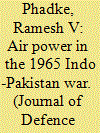

|
|
|
|
|
| Summary/Abstract |
The 1965 Indo-Pak War came when India was in the midst of a major military expansion. India did not want to escalate matters when Pakistani forces invaded Kutch in April 1965 and accepted a ceasefire with British mediation. Although the government allowed the use of Indian Air Force (IAF) combat aircraft on 1 September 1965, action remained localised to the Chhamb area for five days. This was primarily because of India’s desire to avoid all-out war. IAF was used for counter air, air defence, and in support of the ground forces. Poor communications with the Army, lack of joint planning, an almost total absence of early warning and ground controlled interception (GCI) radars meant that its overall performance was sub-optimal. Despite these self-imposed restraints, India succeeded in thwarting Pakistan’s efforts to grab Jammu and Kashmir (J&K) by force, and to that extent the war did become a limited victory for India.
|
|
|
|
|
|
|
|
|
|
|
|
|
|
|
|
| 2 |
ID:
139181
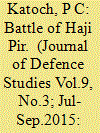

|
|
|
|
|
| Summary/Abstract |
In 1965, Pakistan attempted infiltration into Jammu and Kashmir (J&K), with Operation Gibralter, followed by a planned capture of Akhnoor Bridge under Operation Grand Slam. While Operation Gibraltar was bold from the point of view of multi-directional infiltration, it was largely based on the utopian dream of President Ayub Khan and Foreign Minister Zulfiqar Ali Bhutto, ignoring the ground realities that J&K’s population would not support it. The Indian reaction was swift and included the epic capture of the strategic Haji Pir Pass at a height of 2,637 metres (m) on the formidable Pir Panjal Range that divided the Srinagar valley from the Jammu region. The pass has been a constant source of problems since Pakistan-trained militants have been sneaking into the Kashmir Valley, Poonch and Rajouri districts. Ironically, the Haji Pir Pass, captured through a heroic and daring action, had to be returned to Pakistan under the Tashkent Agreement.
|
|
|
|
|
|
|
|
|
|
|
|
|
|
|
|
| 3 |
ID:
139183
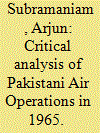

|
|
|
|
|
| Summary/Abstract |
This article tracks the evolution of the Pakistan Air Force (PAF) into a potent fighting force by analysing the broad contours of joint operations and the air war between the Indian Air Force (IAF) and PAF in 1965. Led by aggressive commanders like Asghar Khan and Nur Khan, the PAF seized the initiative in the air on the evening of 6 September 1965 with a coordinated strike from Sargodha, Mauripur and Peshawar against four major Indian airfields, Adampur, Halwara, Pathankot and Jamnagar. The IAF riposte to PAF strikes came early next morning at dawn on 7 September. Over the next ten days, IAF surprised an overconfident PAF with its tenacity and individual combat proficiency. The article concludes by offering a critical analysis of the opeational performance of PAF in the conflict and an objective qualitative comparison with the performance of the IAF.
|
|
|
|
|
|
|
|
|
|
|
|
|
|
|
|
| 4 |
ID:
139182
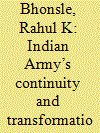

|
|
|
|
|
| Summary/Abstract |
The continuum of change in militaries is derived from a number of factors, in which application of history plays an important part. The process of Indian Army’s evolution in the plains of Western India could be charted from the lessons learnt from key episodes of the 1965 War. The Battle of Dograi was one such feat which though restricted to action by a single infantry battalion, 3 Jat, provides unique perspectives of the manner in which continuity and transformation has occurred in the Indian Army as well as how the lessons learnt can be applied effectively to current operational dilemmas, ranging from Cold Start to countering Pakistan’s battlefield nuclear rocket, Nasr.
|
|
|
|
|
|
|
|
|
|
|
|
|
|
|
|
| 5 |
ID:
139180
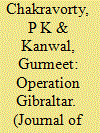

|
|
|
|
|
| Summary/Abstract |
Launched in early-August 1965, Operation Gibraltar was designed to infiltrate several columns of trained and well-armed Mujahids and Razakars, led by Pakistan Army Majors into Jammu and Kashmir. Under the cover of fire provided by the Pakistan Army deployed on the Cease Fire Line (CFL), the columns managed to infiltrate, but failed to create large-scale disturbances and did not receive support from the people. In fact, locals often provided information about the columns to the Indian Army, which led to their being captured or neutralised. By the third week of August, the Indian Army’s counter-infiltration operations had been successfully concluded. Trans-CFL operations were then conducted to capture the Haji Pir Pass and important heights in the Kargil sector. This article revisits Operation Gibralter, the thinking behind it and the tasks set, the execution of the operation, the Indian response and the lessons learnt.
|
|
|
|
|
|
|
|
|
|
|
|
|
|
|
|
| 6 |
ID:
139179
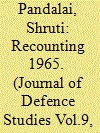

|
|
|
|
|
| Summary/Abstract |
‘Stalemate’, ‘futile’, ‘forgotten’—the descriptions of the 1965 War between India and Pakistan often do injustice to its profound Impact on the history of the Indian subcontinent. It was a war that altered the fates of India and Pakistan both politically and militarily, and officially began the new great game for Asia. For India, it was a test of leadership post Nehru and banishing the demons of 1962. For Pakistan, it was about Kashmir and testing India, playing roulette with the superpowers, and sealing its friendship with China. Fifty years on, this article attempts to understand the myriad motivations of this war and focuses on the political conversations and intense diplomatic manoeuvring that New Delhi undertook to emerge on the right side of history. Approached from an oral history perspective, conversations have been pieced both from India and Pakistan, to study the flash-points of a war, often underscored in its importance in the annals of history.
|
|
|
|
|
|
|
|
|
|
|
|
|
|
|
|
|
|
|
|
|